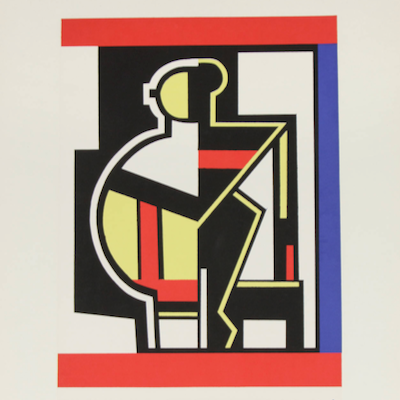
Details
Artist
Styles
Etching and aquatint in colours, on BFK Rives paper, with full margins. - This work is from the UNITÉ book, which began to be printed in 1963 and ended on October 15, 1965 in Paris. - I. 41.5 x 31.5 cm (16 3/8 x 12 3/8 in.) - S. 57 x 45.2 cm (22 1/2 x 17 3/4 in.) - Signed and numbered in pencil, from the edition of 130 pc + 30 in Roman numerals, published by Atelier Crommelynck, Paris // Le Corbusier’s Unité 19 (1963-1965) is a limited-edition etching and aquatint in color, printed on BFK Rives paper. It features an abstract and stylized depiction of a bull, divided into contrasting sections with red and brown dominating the upper and lower parts. The bold, angular lines and bright color palette evoke a sense of energy and strength, reflecting both the power of the animal and Le Corbusier's characteristic approach to form and structure. The use of geometric shapes and layered patterns, combined with the animal’s fragmented representation, suggests a deeper exploration of balance and tension, themes central to Le Corbusier’s work across different media.
Unité 19, 1963-1965
form
Medium
Size
57 x 45.2 cm
- Inches
- Centimeters
Edition
Price
- USD
- EUR
- GBP
Details
Artist
Styles
Etching and aquatint in colours, on BFK Rives paper, with full margins. - This work is from the UNITÉ book, which began to be printed in 1963 and ended on October 15, 1965 in Paris. - I. 41.5 x 31.5 cm (16 3/8 x 12 3/8 in.) - S. 57 x 45.2 cm (22 1/2 x 17 3/4 in.) - Signed and numbered in pencil, from the edition of 130 pc + 30 in Roman numerals, published by Atelier Crommelynck, Paris // Le Corbusier’s Unité 19 (1963-1965) is a limited-edition etching and aquatint in color, printed on BFK Rives paper. It features an abstract and stylized depiction of a bull, divided into contrasting sections with red and brown dominating the upper and lower parts. The bold, angular lines and bright color palette evoke a sense of energy and strength, reflecting both the power of the animal and Le Corbusier's characteristic approach to form and structure. The use of geometric shapes and layered patterns, combined with the animal’s fragmented representation, suggests a deeper exploration of balance and tension, themes central to Le Corbusier’s work across different media.
- Recently Added
- Price (low-high )
- Price (high-low )
- Year (low-high )
- Year (high-low )
What is Cubism?
Cubism is an art movement that aimed to depict multiple perspectives of objects or figures within a single picture. Artists Georges Braque and Pablo Picasso pioneered this style around 1907. The name Cubism emerged from their use of geometric shapes and outlines that often resembled cubes, breaking objects down into abstracted forms.




























